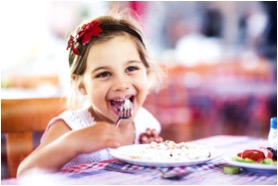
Stephen Cowan, MD, Director of Health & Education
This is the sixth in a six-part series on the Five Phase Journey through Adolescence.
During the great upheavals of change that is the journey of adolescence, you are given the opportunity to help your children discover their own secret powers of wisdom and compassion. As your child reaches the other side of the great hormonal mountain, their identity begins to reestablish some sense of stability around 15-16 years of age. In traditional cultures this was a time for moving out and establishing one’s own family responsibilities. Because we now delay this process through high school, many teenagers feel unsure of their purpose and direction in life. The transition back into the Water stage raises the deepest question of all, “Who am I now that I’ve changed?” Their need for freedom and individuality can at times lead to conflicts as they prepare to leave the nest. Questions about the future may be the cause of unspoken fears and anxiety. Society puts enormous pressure on 10th and 11th graders around college admissions.[i] I have seen kids crushed under the weight of such stress.
Advice for parents:
- The way we think changes outcomes. As parents you need to take a step back, see the big picture and take the time to marvel at the distant they have travelled and to honor the unique power and perspective that got them to this point. When you see their life as a journey rather than a destination you are embodying growth mind thinking which has been linked to long-lasting success.[ii] This is much more likely to support your child’s resilience in the face of stress rather than adding more pressure by being a top-down authority.
- Differentiate between healthy stress and unhealthy stress. Help your teen locate tension within their body. This will enables them to better cope with stress, contain it and release it in healthy ways. Here’s a simple exercise I use with teenagers to help them become more mindful of the source of their stress and practice releasing it. Ask your child to:
- Close your eyes and take a deep cleansing exhale.
- Next imagine a stressful situation in your life.
- Now locate the place in your body (not your mind) where you feel the sensations of tightness or pressure.
- Next breath in and clench your fists tight and feel the tension increase in those stress places.
- Forcefully exhale opening your fists.
- Repeat two more times, each time holding the tension a second or two longer.
- Create opportunities for mentorship. In ancient times apprenticeship was the primary way we learned. Today there is much less opportunity for such personal training. Seek out a healthy role model that your teen can learn from. Likewise, find mini-opportunities for your teenager to mentor younger children. Whenever we practice sharing our gifts with others, we open the path of the true hero.
- Practice what you preach: Remember that like you, your child is searching for a sense of purpose in their life. You are being asked to let go of the child you have invested so much love and time in. Are you willing to grow in new ways at this important moment in your life? Your growth will bring a greater sense of wholeness to both you and your child. In the end, this guarantees long-lasting harmony between you. And this is one of the keys to a life of love.
[i] https://www.nyu.edu/about/news-publications/news/2015/august/nyu-study-examines-top-high-school-students-stress-and-coping-mechanisms.html
[ii] Check out this interview with Carol Dweck for the Harvard Business Review on mindset and success https://hbr.org/2012/01/the-right-mindset-for-success

Deepika, Tournesol Kids volunteer
All parents want their child to grow up to be confident, amazing individuals. They want their children to be successful and happy. They want to teach their kids about resilience and persistence so that they can bravely face the world during the tough times and come out of those troubled waters with a smiling face. A parent wants the best for the child!
How do we accomplish that? As a child grows up, it is the responsibility of the parent to ensure that they empower and nurture their child with the right qualities. Empowering a child is a process of guiding them to feel and believe that they are powerful and that they can achieve their dreams. Empowering a child means trusting them, loving them and encouraging them.
Here are few tips on how to empower children so they can grow into happy, confident and resilient adults:
- Connect and communicate: We lead busy lives filled with work, cleaning house, cooking meals, groceries and ensuring children get to school and their activities. In midst of all these activities, sometimes we forget to take the time to connect and communicate with our children. It is important to connect with your child. Parents should not only listen to what they say but also observe their moods. Spend time with your children, listening to them about their school, friends and anything else they wish to share with you. Encourage them to talk.
- Encourage choice: Encourage your children to make decisions. Slowly give them more power over their choices. Initially it can be choices about healthy breakfast or choosing their outfits. Don’t discourage the children over the choice. For example if they make they an unhealthy choice for breakfast, discuss with them about their choices and let them choose. With time as the child grows they will make rightful choices about important decisions.
- Encourage empathy: It is important to teach our children about empathy and helping others. You can start with something small like donating food to charities or helping in community clean-ups. Parents should participate along with their children in various activities, as the child learns & grows by mirroring.
- Encourage adventure and curiosity: It is important that as parents we encourage the curiosity of our children. It can be about learning more about planting or exploring the national park nearby or trying the big slide. As a parent we should encourage our children to explore and take risks (at an accepted level) so that it develops their self- confidence, their adventure and allows them to understand their environment.
- Encourage a positive and realistic self-image: It is easy to praise our child by telling them that they are the best in whatever they do. It is important to encourage but in a positive and realistic manner. We face tough situations in life and it is important that we build our resilience and be persistent towards our goal. As parents we are responsible for ensuring that our children develop this resilience and persistent. We can achieve this by ensuring that we encourage our child to keep trying until they succeed.

Stephen Cowan, MD, Director of Health & Education
This is the fifth in a six-part series on the Five Phase Journey through Adolescence.
As children move further into the depths of adolescence, the changes in their bodies cause increasing concerns about personal appearance. Every pimple is a crisis of imperfection. Your child’s style of clothing and hair may begin to take on quasi-religious importance. Your teen’s “look” is an outer form of their emerging personal identity. The transition into the Gold stage drives children to develop a strong sense of justice and righteousness. “Why” questions are deeply spiritual inquiries into the rules and order of society, creating all kinds of logics of cause and effect, some of which may make absolutely no sense to you. Teens become consumed with questions like, “Why is it that one minute I’m popular and the next I’m not?” The advertising media capitalizes on this existential crisis, creating unnatural distorted ideals of self-image that can exaggerate the sense of your child’s imperfections. How can anyone live up to a photoshopped image? Some “early bloomers” hide their sexuality while others feel the urge to dress in more mature styles. This can create an inner conflict between appearance and emotional immaturity.
During this Gold stage, teenagers become more concrete in their thinking. They may have difficulty anticipating consequences and tend towards fixed mind black-and-white thinking. I once had a conversation with an adolescent specialist who had been doing an MRI study on the typical teenage male brain. An anthropologist happened to come by and asked, “Hey where did you get all the Neanderthal brains?” He noticed that the part of the prefrontal cortex that enables us to plan ahead was underdeveloped just like the brains of cavemen they had discovered.[i] When I explain to parents that they have a Neanderthal living in their house, suddenly their child’s rigid behavior makes sense. So how do you deal with a Neanderthal?
Advice to parents:
- First rule: Never tell a Neanderthal that they’re a Neanderthal! No teenager wants to be told they’re acting like teenagers. This just generates more humiliation, resentment and resistance, diminishing the chances they’ll hear anything you say.
- Second rule: repeat exactly what they say so they know you heard them. Teenagers often feel like they’re not being heard or understood. When your teenager growls, “I don’t want to do my homework!” for example, resist the temptation to use reason to explain why homework is important to their future. Instead, try repeating exactly what they said back to them: “You don’t want to do your homework, do you?” You may find this is a much more effective way of getting them to shift out of the resistant state of NO just by getting them to say the word YES. When your child first senses they’ve been heard, you have miraculously created trust and dignity that opens the door to a willingness to reconnect with you.
- Connect present feelings to how they felt in the past. Remember to use shades of feelings (see Fire stage). By comparing present feelings to some other time, they gain a wider perspective that reduces the sense of being overwhelmed. After all, we recovered from feelings before, we can have the faith to recover again.
- Practice what you preach! Your own spiritual practice can have a profound influence on your child’s life. Try creating sacred ceremonies in your life that connect you to something bigger than yourself. This will have an effect on your child even if they roll their eyes and don’t participate. Teach by example without the lectures. Work with your own energy through exercise like qi-gong, yoga and meditation to regulate metabolic functions that are key to good health. You will serve as a wonderful role model of what empowerment looks and feels like during difficult and stressful times.
[i] For a good overview of the way the brain grows and changes during development and the correlations to cognitive growth see: The Evolution of Human Brain Development Neubauer and Hublin Evol Biol (2012) 39:568–586
Michele Zipper, Tournesol Kids Coach

In a world where human beings keep moving faster, we all too often stop living in the moment. The pull of getting things done quickly and jumping to the next task has become a great societal problem. Fortunately, there are many solutions to bring our attention back to the present. Here’s the spoiler, one of the best ways to live in the here and now, is to eat!
The WHY we should slow down is really interesting. Digestion begins in the mouth; saliva contains enzymes that help break down food particles before entering the digestive tract. The longer food is exposed to saliva through chewing, the easier it moves through your intestines and the less gas it creates. This will kick start the digestive process and allow proper absorption of vitamins, minerals and other nutrients, which is essential for optimal health.
When it comes to kids, we want them to slow down because we want them to develop healthy eating habits. Yes, we want them to eat less refined carbs and sugar, more fruits and vegetables, and whole grains, but they also need to develop a healthy relationship with food. We need to teach them to eat mindfully, to pay attention to the food they eat and to how it affects our bodies physically and mentally, so they can find more joy in eating. It will also increase the likelihood they will become familiar with what feelings of hunger and fullness actually feels like.
So how do we do this exactly?
Teach them about Hunger
Our kids need to understand why he or she is eating. There are 3 different triggers for eating – hunger, appetite, and emotion. A fun exercise to try with kids is before sitting down to a meal, ask your child how hungry they are on a scale of 1 to 10 and together try to figure out which trigger is making them want to eat.
Let them be Active Contributors
This part of mindful eating doesn’t involve tasting or chewing but is nonetheless equally important. In generations past, children learned from an early age the arts of preparing meals. Your younger children are probably eager to help wash and prepare vegetables (oil brushes are tons of fun!), mix ingredients and stir pots, with careful supervision of course. Teens and preteens can be great helpers in more complex tasks of mincing ingredients, spreading layers of lasagna or casserole and with proper tools and protection, taking food out of an oven or off a grill. All of these tasks are essential life skills to teach your kids. And a side benefit is when kids take part in preparing their meal, they are more apt to try new foods!
No More Food Rules
Teaching your kids mindful eating means putting an end to any food rules you currently have. Forget about having to take a few bites of veggies before they can have dessert, requiring they clean their plate, or to have a bit of everything before they can leave the table. Chances are both you and your children will feel more relaxed at mealtimes when you’re not engaging in power struggles around food or trying to control every bite they put in their mouths.
Know Who Makes Food Decisions
Your job as a parent is to decide what to offer and when and where to provide it. Your home is not a restaurant where your child can choose anything they want off of the menu, and you are definitely not a short order cook. At meals and snack times you can offer healthy foods for your kids to choose from and eat. Their job as kids is to decide if they are going to eat the food you’re offering. And how much. It’s that simple.
Turn off Distractions
Yes, this definitely means turning off the TV and checking your phones at the kitchen door. If you’re distracted, they will be too. Also, take check of how your kids are eating their meals. We know you’re running back and forth from soccer practice to dance rehearsals, but try and make sure to get at least three family meals in a week, if not more. It doesn’t have to be a Friday night or Sunday night event.
Teach them Gratitude
This doesn’t mean you have to say Grace at the table, but you should take a moment to take a breath and say thank you for your food and everyone involved in growing, preparing and bringing the food to your plate before each meal. Expressing gratitude at mealtime reconnects us to our roots and the earth’s great ability to sustain and nourish us.
Serve Meals Family Style
Serve the food in the middle of the table, and allow them to serve themselves. This will enable them to become familiar with appropriate serving sizes and also empowers them to make their own choices. Plus it’s less work for you!
Engage all 5 Senses
We want them to engage all five of their senses when eating foods. Here is a mindfulness activity adapted from SMArt Kids Practice Mindful Eating. Have them put one piece of food in their mouth and play scientist.
- Look – what colors and shapes do you see?
- Listen – does your food make a sound when you eat it?
- Touch – is it smooth, bumpy or rough?
- Smell – what does your food smell like?
- Taste – when the food is on your tongue, notice how it feels in your mouth. Do you taste anything yet? Start to chew, does the flavor change? How many different flavors are there and do you taste salty, sweet, sour, or bitterness?
Recognize a Full Belly
Assess hunger mid-meal to see if you are full, almost full, or ready to stop. You don’t have to finish your meal, ever. This is where you listen to your body and let it decide if you’ve had enough. Did you know it takes the brain approximately 20 minutes to know that you have had enough food?
Lastly, remember you are their teacher and role model. Mindful eating is beneficial for everyone, not just kids. They are watching everything you do. When you sit down to eat and are fully present, with no electronics or other distractions, enjoying your food and eating a healthy, balanced meal, your kids will learn to follow your example.

Stephen Cowan, MD, Director of Health & Education
This is the fourth in a six-part series on the Five Phase Journey through Adolescence.
Let’s face it, transitions make us crazy. You’re neither here nor there. One of the ways children move through the transitions of adolescence is by creating new relationships outside the family. The loyalty of friends takes on increasingly important meaning in a teenager’s life. This new interest in social dynamics is a sure sign of the transition into the Earth stage which asks “How am I going to get through this?” Equally important, questions about “How am I fitting in?” take on a new sense of urgency, as if survival depends on it (and maybe it does). As the subculture of the teen emerges, it has the power to shape your child’s interests and desires. Your child may be privately grappling with peer pressure, bullying and gender identity. As they move out into their own peer group, they may become less willing to share their thoughts and interests with you. Try not to take this too personally. Maintaining open communication during adolescence can be challenging for any parent and child. Forced exchanges end up sounding like FBI interrogations and never work. What is critically important here is to create mini-opportunities for your teen’s voice to be heard within the safety of small talk that has no strings attached. These exchanges are the keys to empathy. That’s how we both learn what we need in order to grow.
Advice for parents:
- Develop a tradition of storytelling in your family. This is one the most powerful ways we strengthen family bonds. Telling stories about your feelings and your childhood experiences can help your children feel less alone, enabling them to build confidence by connecting to the big picture of their life.
- Go for a walk or drive with your child. Find opportunities that involve movement without demanding eye contact. This creates a safe place for your child to open up naturally without feeling coerced.
- There is a lot of misinformation being passed around among teenagers these days. Remember to listen openly to your child’s opinions. Be a voice of compassion and curiosity, not judgment and inquisition. You don’t need to have the solution for every problem they voice so don’t try to fix everything. Create an even playing field of trust through conversations, by exploring answers together.
- Connect feelings to needs. Feelings and emotions are natural expressions of our unmet needs. When your child can make this connection, they are much less likely to blame others for their feelings. This reduces the tendencies to see themselves as victims, opening their hearts to empathy. To power to imagine what another needs heals all conflicts and promotes healthy growth.
- Practice what you preach! If you want your child to bond with you, consider asking their opinion about a problem you are having. This is a great way to gain their respect and let them feel like they are an important contributor to the family.

by Deepika, Tournesol Kids volunteer
We are all aware of IQ (Intelligence quotient) and EQ (Emotional quotient) and their importance in our day to day lives. However there is BQ (Body quotient) which plays an important role. Body Intelligence means being attuned to and living within the rhythms of life around you (living in context). It is being present, being able to show up and having a deep sense of wellbeing. Our bodies are constantly communicating with us. Research has shown that this is critical to developing a healthy immune & nervous system.
Eating, sleeping, moving, playing, and breathing are all basic functions that we need to be healthy. The Tournesol program encourages teachers and parents to practice body intelligence exercises with their children so that it can be incorporated to become a natural part of their daily lives.
There are various exercises for children based on their secret power. The exercises address the most essential needs for growth and help manage body rhythms that connect the child to their surroundings.
Few of the exercises are:
- Mindful eating: Eating is one of the basic ways we stay connected to our context. It’s not just what you eat, but when, where, how, and why you eat that empowers growth and learning. Practicing with children to read labels before preparing/eating food allows them to appreciate, learn and understand healthy eating habits.
- Belly breathing: Breathing is the most fundamental rhythm we need for growth. In each moment you are taking in your context and giving back what you don’t need. Belly breathing helps to clear the mind of stubborn thoughts and relax the body. This is a simple mindfulness breathing exercise to practice with children when they are stressed and before bed to help them fall asleep more easily.
- Jam Jong (Standing like a Tree): Found in almost every tai chi class. It involves standing still like a tree for a certain period of time. You should concentrate on relaxing the body and mind while maintaining correct body structure while taking slow calm breaths. This exercise has been known to help the sick recover their health and make them strong.
- Play Catch: Play a game of catch helps in developing significant hand-eye coordination.
- Dancing: Dancing along with the music in a fun and silly way helps build the movement as well as improve the sensory connections of the child.
- Interactive free play: Allows the child to develop their curiosity & explore their sense of adventure. It also promotes learning through hands-on trial and error.

Stephen Cowan, MD, Director of Health & Education
This is the third in a six-part series on the Five Phase Journey through Adolescence.
As your child moves deeper into adolescence, you may notice their moods becoming more dramatic and volatile. Impatience is one of the hallmarks of the transition into the Fire Stage. When strong impulses arise, they can easily overwhelm your child. These represent the pulses of hormones surging through your child’s veins. Inwardly your child may be asking, “What’s happening to me?” and “When is it going to end?” as physical changes begin to manifest outwardly. Breast buds and pubic hair are only the beginning of the profound inward changes taking place. Children often cannot imagine that you could possibly know what they are experiencing. Urges to privately explore their own changing body open them to new feelings of sensuality. Children during the Fire stage are highly impressionable and easily influenced by outside opinions. Sudden shifts in emotion can drive impulsive cravings and risk-taking behavior. Advertisers take advantage of these impressionable young teens and the internet is awash with misinformation and dangerous predators.[i] Poor dietary habits can contribute to these intense mood swings. Junk food, excessive sugars, carbohydrates and the recent fad of stimulant drinks all feed these erratic behaviors, contributing to physical changes such as acne, obesity and blood sugar instability that enhance vicious cycles of emotional meltdowns and panic attacks.[ii]
Advice for parents:
- No matter how much drama is happening in the moment, try to keep the big picture in your mind and hold the image of your child as a true hero in your heart. This is the basis of unconditional love and it has the power to support your child especially when they are feeling ungrounded by the transition. Remember, the true hero faces challenges and that’s exactly what your child is doing.
- Expect and respect volatility in your teen. During dramatic episodes, there is a refractory period when reasoning with your child simply will not work. Give your child space and time to recover from mood shifts and then acknowledge their ability to recovery. This will empower rather than shame them.
- Don’t lose your sense of humor. Fire corresponds to the human comedy. Be able to laugh at yourself in order to laugh with your child not at them! This may be one of the best ways to diffuse the intensity of drama.
- Develop a vocabulary of shades of feelings e.g. angry level 1-2-3. Fire power reflects our whole range of feelings and emotions. The more shades of emotions you and your child can notice, the less overwhelming they become. As I always tell children, feelings are just the weather happening inside you. Even the strongest storm of emotion is guaranteed to change. This practice will come in handy in later stages of adolescence.
- Leave reading material in your child’s room that offers accurate information about the physical changes for them to explore on their own. [iii] Create opportunities to privately discuss what’s happening but don’t force your child to discuss things if they’re not ready. Follow their lead.
- Practice what you preach! Remember, developing healthy habits of eating, sleeping and media exposure begins with you.
[i] https://pediatrics.aappublications.org/content/138/5/e20162592
[ii] https://www.cdc.gov/nchs/data/databriefs/db213.htm
[iii] A good example of a book that treats sexual changes with humor and without shame is “It’s perfectly Normal: Changing Bodies, Growing up, Sex, and Sexual Healthy” by Robie Harris 2009.

by Alicia Webb, PR Specialist
“Self-awareness is one of the rarest of human commodities. I don’t mean self-consciousness where you’re limiting and evaluating yourself. I mean being aware of your own patterns.” –Tony Robbins
Self-awareness is defined as conscious knowledge of one’s own character, feelings, motives, and desires. It isn’t simply about how we notice ourselves but how we notice the world around us. For young people, developing self-awareness takes time and the idea needs to be embraced by students, parents and educators. Self-awareness is developed through practices, it isn’t learned from a book.
When young people are self-aware, they have a much better understanding of themselves and can experience things as unique individuals. Being self-aware also allows children to manage stress and appropriately make changes. Those who are self-aware also are better positioned to be leaders in the future. One of the primary goals of Tournesol Kids is to promote optimal development in children, with self-awareness being one of those focus areas.
Some key ways to develop self-awareness include:
- Looking at yourself objectively
- Keeping a journal
- Writing down goals and plans
Many experts agree, completing personality and psychometric tests help in the development of self-awareness. Through Tournesol Kid’s first program, #PowerUp, children are exposed to a holistic health education series that provides a simple and profound way to achieve cognitive, emotional and physical development.
Developed by Dr. Stephen Cowan, the world-renowned pediatrician, #PowerUp asks children compelling questions via an assessment including, “Do I like to take risks and look for challenges?” and “Do I like to wait for others to lead the way?” The answers to the assessment help them establish their individual powers in area such as empathy and gratitude. Cowan utilizes the growth mind, which acknowledges the idea that with the right thinking, students can become bigger and stronger with both their brains and hearts. The #PowerUp program is unique because it combines the science of growth mindset with mindfulness and compassion to give kids skills to use in the face of challenges.
To learn more about #PowerUp and helping your child develop self-awareness, visit http://courses.tournesolkids.org/.

Stephen Cowan, MD, Director of Health & Education
This is the second in a six-part series on the Five Phase Journey through Adolescence.
Somewhere between the age of seven and ten years old, depending on your child’s inherent nature, the Wood stage of transformation begins. Out of the relative hibernation of preteen’s wintry innocence comes the subtle signs of transition. Remember that change comes in different ways to different kids. No two kids raised in the same house pass through this transition in exactly the same way. A child with Wood power may begin changing first while a Water child may move through this transition much later.
Take the Tournsesol Kids assessment here to see which power your child has the most of.
Just like the smell of springtime in the air, the first signs of body odor coming from your child herald the awakening of the Wood stage. Wisps of underarm or pubic hair are sure to follow. One of the earliest signs you may notice of adolescence transition is that your child’s sleep habits are changing. Your child may begin having difficulty falling asleep at the usual times. Likewise, they may have trouble waking up in the morning. Children do most of their growing at night and the spurts of growth hormone tend to energize a child in the evening, just when you’re ready to go to sleep. Your child may start asking for more privacy. I think in ancient times, these teenagers were the keepers of the fire when we poor tired adults retreated to our caves, leaving them to develop their own subculture. These are the first stirrings of Wood energy, the primal need for separation and independence.
In our modern mechanized society, we no longer allow for these subtle changes in our children. Most of the adolescents I treat are chronically sleep deprived. At night they are plugged into high-energy screens (TV, phone, video games) that trick the brain into thinking it’s daytime and suppress the natural melatonin levels that signal sleep. Supplementing with melatonin is at best a quick fix solution which overtime loses its effect while raising the risk of further suppressing the natural capacity to produce melatonin. School schedules further compound the loss of day-night rhythms by failing to accommodate these adolescent changes. In fact, preteens and teens are typically expected to get to school earlier than younger children, despite specific recommendations by the American Academy of Pediatrics to delay start times for middle schoolers.[i] Studies have shown that chronic sleep deprivation puts undue stress on the growing child’s metabolism and may contribute to excessive mood swings, poor attention, and immune dysregulation.[ii] There is evidence that these stressors may be factors associated with the increasing shift towards earlier puberty that we are witnessing in this country.[iii]
Advice for parents:
- Look for subtle changes in sleep cycles and explain (without judgment) the interconnection between sleep, growth and puberty.
- Allow your teen to get their sleep needs in on the weekend. (They will thank you for this!)
- Wood power is planning power. Come up with a plan with your child to turn off screens well before sleep time to allow for transition into sleep. This is a good time to practice some breathing exercises together.
- Screen time = Green time. Nature has a calming effect on our mood, providing more opportunity to get exercise and release pent up feelings. Try making a new house rule; for every minute of screen time, you have to have an equal time in nature. Even ten minutes in a park can refresh your life.
- Practice what you preach! Make sure you turn off your screens and get enough sleep too. (You’re going to need it in order to deal patiently with your teenager in the coming years.)
[i] https://pediatrics.aappublications.org/content/pediatrics/134/3/642.full.pdf
[ii] Chen MY, Wang EK, Jeng YJ. Adequate sleep among adolescents is positively associated with health status and health-related behaviors. BMC Public Health. 2006;6:59
[iii] http://gaylesulik.com/wp-content/uploads/2010/07/falling-age-of-puberty.pdf
by Deepika, Tournesol Kids volunteer

Carol Dweck, an eminent psychologist, showed through her research that there are two types of mindsets: a fixed mindset and a growth mindset.
In a fixed mindset, people believe their qualities are fixed traits and cannot change. They also believe that talent alone leads to success, and effort is not required. Those stuck in fixed mindset thinking speak in generalizations, taking things out of context and dividing the world into black/white, right/wrong, good/bad, success/failure. This is a deep source of conflict in our world today.
A growth mindset is “the understanding that abilities and understanding can be developed.” Those with a growth mindset believe that they can get smarter, more intelligent, and more talented through putting in time and effort. People believe that their basic abilities are simply a starting point and that everyone can become smarter if they try.
These days many children become conditioned to think that their mind has a finite capacity to contain information. Due to the various rigid standards set by the education curriculum, it tends to promote fixed mind thinking. Children (& adults) who use fixed-mind thinking imagine their mind to be like a file cabinet. In an effort to keep up with the pressures of a standardized one-size-fits-all curriculum, students and teachers run the risk of losing a personal connection to the learning experience. The smaller the box we try to squeeze kids into, the more kids are bound to fall outside of the box.
In reality, research has shown through neuroplasticity that our mind is more like a plant that keeps branching outward, making new connections and growing. This is the real power of growth mind thinking. The Tournesol Kids Program teaches coaches, teachers, parents and children how to recognize the signs of fixed mind thinking as a sign of deep insecurity in need of support.
There are eight general approaches for guiding& developing the foundation for a growth mindset that teachers and parents can apply:
- Create a new compelling belief: a belief in oneself, in their own skills and abilities, and in their capacity for positive change.
- View failure in a different light: see failure as an opportunity to learn from experiences and apply what they have learned next time around.
- Cultivate self-awareness: work with the children and help them become more aware of their talents, strengths & weaknesses.
- Be curious and commit to lifelong learning
- Get friendly with challenges
- Help children develop the passion. When they love what they do, they can focus and succeed much better.
- Be tenacious: Teach the children to be curious and adopt a hard working nature. It takes a lot of hard work to succeed, weathering obstacles and getting back up after each time you fall.
- Inspire and be inspired by others: it can be tempting to envy others when they succeed, especially if they go farther than you, but it will not help you to succeed; commit to being an inspiration to others and use the success of others to get inspiration as well.
